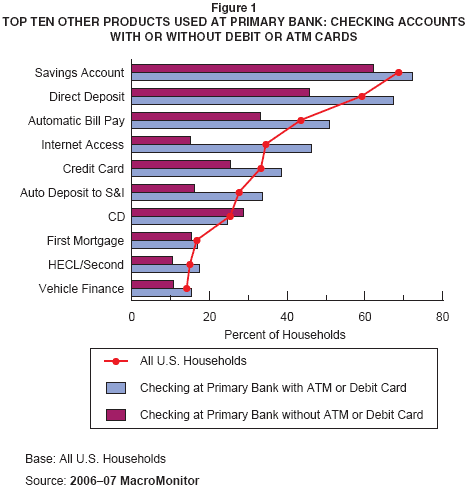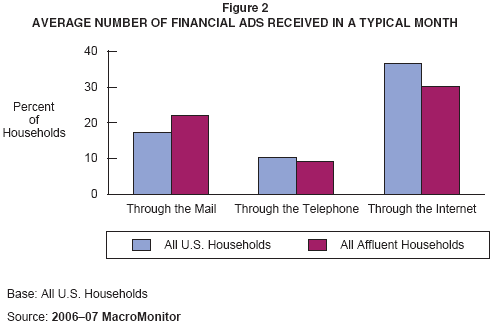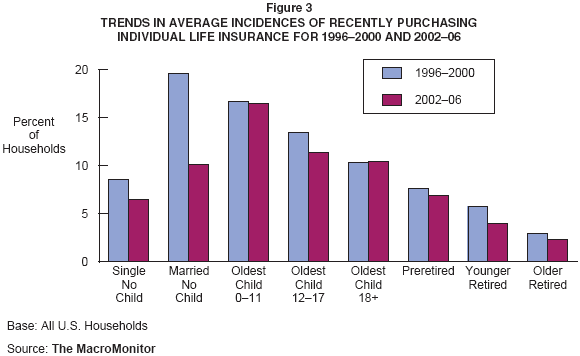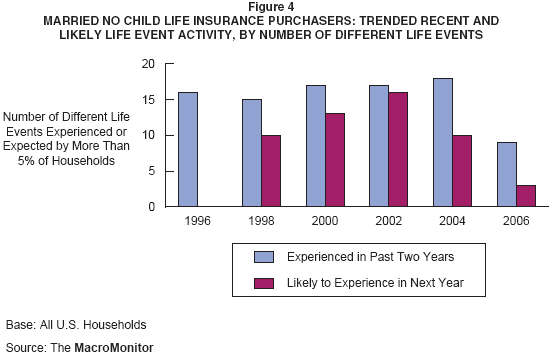MacroMonitor Market Trends November 2007
MacroMonitor Market Trends highlights topical news and trends of interest to you and your colleagues. If you would like more information about the items in the newsletter or would like to discuss other ways that we can assist you in your research and marketing efforts, please contact us.
In this issue:
ATM or Debit Card Use Enhances Cross-Selling at the Primary Bank

Since 1994, the MacroMonitor has measured financial products and services that households have or use at their primary bank, primary insurer, and primary investment firm. Figure 1 shows the incidences of ownership of the top ten products (other than checking accounts and debit or ATM cards) held at their primary bank by households that have a checking account but not a debit or ATM card at their primary bank, by households that have a checking account with a debit or ATM card at their primary bank, and by U.S. households overall.
As Figure 1 shows, households that have a checking account but not a debit or ATM card at their primary bank are more likely to own a CD there, too, than are U.S. households overall and households that have a checking account and a debit or ATM card at their primary bank. By contrast, households that have a checking account and a debit or ATM card at their primary bank are significantly more likely than U.S. households overall also to have eight of the other top ten products at their primary bank, except a first mortgage or CD. These eight products include savings accounts, direct deposit of payroll or government checks, automatic bill-payment services, Internet access, credit cards, automatic deposits to savings and investment accounts, junior mortgages (home equity lines of credit and second mortgages), and vehicle loans or leases.
Many assumptions that one could make about the characteristics of households in these two segments are borne out by our demographic data. Households with a checking account without a debit or ATM card are more likely than households in the other segment to be older, to be retired (or preretired), and to have a high-school diploma or less. Households with a checking account and a debit or ATM card at their primary bank are more likely than households in the other segment to be younger, have younger children, and have a college degree. The data confirm the wisdom of including a debit or ATM card in the core bundle of banking services and support the notion that new ways of transacting are crucial to advancing future cross-selling efforts at banks.
Financial Ads Miss the Mark
Financial providers attempting to reach the Affluent may need to adjust their marketing strategy by directing more resources to targeted online advertising. Our 2006–07 MacroMonitor data show that the average Affluent household received 28% more financial advertisements via the mail than did the average U.S. household (22 ads in a typical month, in comparison with 17, respectively). The data also reveal that Affluent households received 18% fewer financial ads through the Internet than did households overall (an average of 30 ads in a typical month versus an average of 37 ads for U.S. households).
Gen X/Gen Y households—generations that came of age with the Internet—now constitute 30% of the Affluent market. Mail and phone pitches for financial products and services may need to make way for more online marketing so as not to miss a significant segment of the Affluent market.

Households That Have Fewer Life Events Buy Less Individual Life Insurance
When we examine data from our past five surveys, we find a correlation between the number of life events that households experience and the incidence of their buying life insurance. We first looked at incidences of the CFD Life Stage segments' recent life-insurance purchase behavior in our data from 1996 to 2006. We averaged incidences of purchase in the past two years for 1996, 1998, and 2000 and for 2002, 2004, and 2006. In our initial finding, the highest average incidences of recently purchasing individual life insurance occur among the younger Life Stage segments. For all but one segment—Married No Child—incidences are relatively consistent for each segment in each of the two combined survey periods. In the survey period 1996–2000, an average 19.6% of Married No Child households reported purchasing life insurance in the past two years; however, in survey period 2002–06, an average of just 10.1% purchased individual life insurance recently. (See Figure 3.)

To explore why Married No Child households show a decrease in their life-insurance purchase activity in the more recent years, we looked at those households that purchased individual life insurance in the past two years in terms of their recent and expected life events for each of the six survey years in Figure 3. We count an event if more than 5% of Married No Child households that bought insurance experienced the event in the past two years or expect to experience the event in the next year. Figure 4 shows the results of this analysis.

In Figure 4 we can see that, among Married No Child households that purchased individual life insurance in the past two years, the decline in purchase of individual life insurance correlates highly with the decline in the number of life events that those households experienced. Only time will tell if this correlation represents a permanent change in the behavior and experiences of Married No Child households, but the implication that the frequency and specific nature of life events might explain or predict life-insurance purchase raises the question of how the two might be related across all Life Stages.